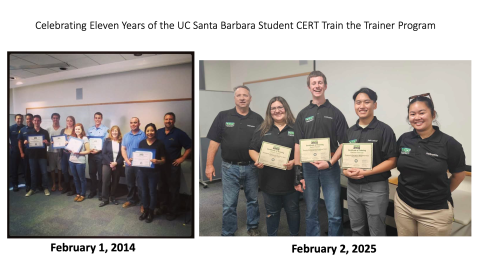History of CERT at UC Santa Barbara
Since the inception of CERT at UC Santa Barbara, Campus Emergency Manager Jim Caesar who oversees the program on campus, has managed the program to be taught over 60 times since 2010. CERT classes have brought in Santa Barbara County Fire Department Station 17 and other community CERT trainers/experts to assist in teaching the class.
CERT in FEMA
CERT was developed and implemented by the Los Angeles City Fire Department in 1985. Soon after, the Whittier Narrows earthquake in 1987 threatened a major disaster in California. This enhanced the need for training community members to be proactive in emergency situations.
CERT became a national program in 1993 and now has programs in all 50 states, with additional tribal nations and US territories participating. Each program is unique to its own community and has become a vital part of emergency preparedness in the US. Currently, there are more than 3,200 CERT programs nationwide, with more than 600,000 CERT Volunteers trained since the inception of CERT.
Trainers of CERT
Other college campuses offer CERT training, but UC Santa Barbara is unique in that it is the only university that trains students to teach CERT through a Train the Trainer Program that is offered after completing the basic CERT class. Liliana Encinas of Santa Barbara City Fire co-trains this 20-hour course alongside Jim Caesar, which equips trainers to teach other community members emergency preparedness skills. UC Santa Barbara is now in its 11th year of the program, having taught countless instructors. See People Page for the full list of trainers.

Why?
With the increasing intensity of climate change, our campus community must be equipped with the knowledge and tools to mitigate its impacts. We offer these essential resources at no cost, making them accessible to all students and enhancing our collective capacity to face climate hazards.
Goals
Our goals include educating students on disaster preparedness and climate resilience, offering hands-on training for emergency response, and building a stronger, informed campus community through regular outreach and engagement. By providing this service, we aim to create a safer, more resilient environment for UCSB in the face of future challenges.
Mission
Ultimately, we aim to do the greatest good for the greatest number, to help UCSB mitigate, prepare, respond, and recover from disaster, and to assist campus, local, state, and national emergency response organizations in their aims.